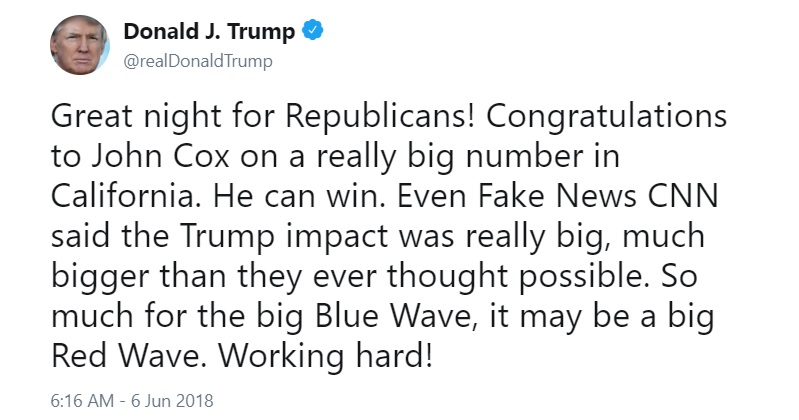Trump’s ‘great night for Republicans’ in the California primaries wasn’t so great after all

On Wednesday morning, President Donald Trump congratulated himself — and, oh yeah, his party — for its showing in Tuesday’s California primaries.
“Great night for Republicans!” tweeted Trump. “Congratulations to John Cox on a really big number in California. He can win. Even Fake News CNN said the Trump impact was really big, much bigger than they ever thought possible. So much for the big Blue Wave, it may be a big Red Wave. Working hard!”
Trump gets one thing right in this tweet: John Cox, until relatively recently a resident of Illinois, did qualify for one of the top two spots in the California governor’s race — alongside Lt. Gov. Gavin Newsom. (The problem for Republicans, of course, is that a one-on-one matchup between Newsom and Cox is likely to heavily favor the Democrat, given the lean of the Golden State.)
Even if you give Trump that Cox victory, however, his claims about Tuesday’s results in California suggesting a “big Red Wave” are badly misguided.
Going into Tuesday’s vote, there were major concerns among Democratic strategists that the state’s odd “jungle primary” system could spell doom for their side. Under the primary system, which was approved by voters in a ballot initiative in 2010, all candidates run on the same ballot. The top two vote-getters, regardless of their party affiliations, advance to the November election.
Because of the massive outpouring of Democratic candidates in the wake of Trump’s election in 2016, the party was faced with the very real possibility in a number of swing congressional districts of splintering the vote between so many candidates that the more limited number of Republicans running secured both of the top two spots.
This, from the Center for Politics at the University of Virginia, set those stakes clearly:
“The intricacies of the top-two format explain why the Democratic Congressional Campaign Committee and its allies have had to dump several million dollars (so far) into three Republican-held Southern California seats, CA-39, CA-48, and CA-49, before the primary because the Democrats are worried about not advancing candidates to the general election in one or more of those districts. This is why the California primary is by far the most important House primary this year, and not just because California has the largest share of U.S. House seats (about one-eighth of the 435 total, 53). Rather, it’s mostly because the California primary could decide races in June.”
That nightmare didn’t come to pass on Tuesday. Far from it. As Cook Political Report House editor David Wasserman tweeted early Wednesday morning:
CA districts where one party will *not* appear on fall ballot, as results stand now:
GOP: 10/53
Dems: 0/53— Dave Wasserman (@Redistrict) June 6, 2018
That means that in all seven — yes, seven — Republican-held California House seats that Hillary Clinton won in the the 2016 election, Democrats will have a candidate. That’s a very big deal — particularly when you consider that if Democrats can win five or six of these seats that amounts to one-quarter (or close) of the total of 23 seats they need to net to win back the majority in November.
Also, not for nothing: It appears as though Republicans will be shut out of Sen. Dianne Feinstein’s re-election race — as the incumbent led the field with almost 44% of the vote and state senator Kevin de Leon appears to have secured the second slot.
Now, California is among the most Democratic states in the country. That Democrats did well in the state on Tuesday isn’t a massive surprise. But there were real — and valid — concerns heading into Tuesday’s primaries that the party might well cut off its nose to spite its face in the Golden State.
That simply didn’t happen. Democrats preserved virtually all of their opportunities on Tuesday night in California. And that means their solid chances of retaking the House majority in the fall remain very much intact.
Sorry, President Trump.
[CNN]